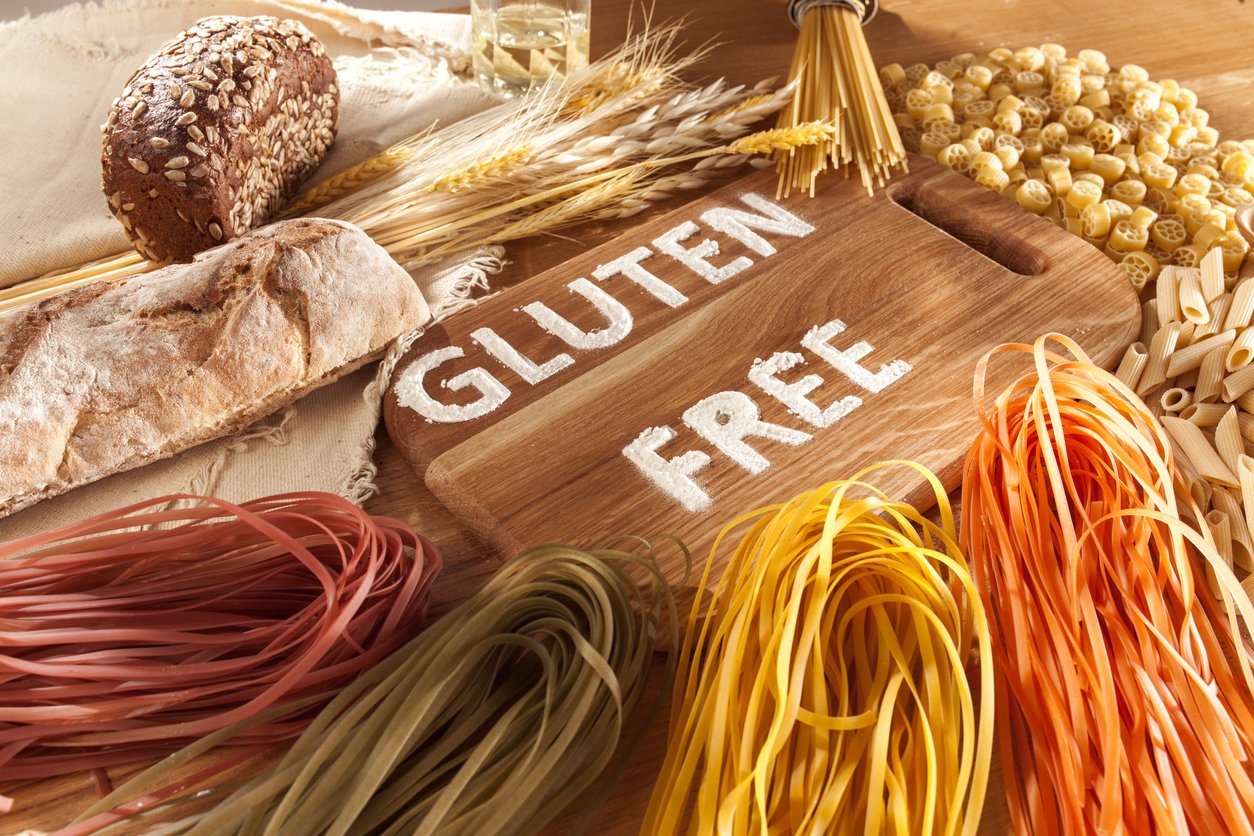Millions of people around the world have gone gluten-free in the last decade. A 2015 Gallup poll found that around one-fifth of Americans and many Europeans prefer gluten-free foods.
So it makes sense to ask the question: should we avoid gluten? Is it bad for our health? Should everyone go gluten-free, or just certain people?
Ordinarily, these questions would lend themselves to pretty straightforward scientific inquiry. Researchers would examine different populations, explore the biochemistry of gluten in the human body, and conduct randomized trials to see the results of different dietary patterns.
All this work is already out there — and we’ll talk about a lot of it in this article. But talking rationally about gluten has become difficult for a couple of reasons. First, there’s a lot of money in convincing as many people as possible not just to avoid gluten, but to purchase manufactured gluten-free analogues and substitutes. By 2020, the gluten-free foods market is projected to reach $7.59 billion in the United States alone.
Second, gluten has become a pawn in the culture war between vegans and meat lovers. Many in the Paleo and keto communities cite gluten concerns as evidence that plant-based diets are inferior to those containing large amounts of (gluten-free) animal products.
When financial interests and cultural forces intersect, the truth often suffers. The “You’re-either-with-me-or-against-me” attitude can undermine the good-faith pursuit of truth, and the millions of dollars at stake can fund pro-industry propaganda at the expense of facts.
What to Expect in This Article
In this article, we focus on the actual evidence. We explore what the science says about gluten, who can benefit from avoiding it, and whether it might actually be beneficial for some people.
And we want to remind you upfront that you know more about your body than anyone else does. More than the marketers trying to sell you their products. More than the scientists searching for trends in large populations. And more than your social media friends and acquaintances sharing the latest blog post on why you should never touch wheat. Or why your so-called gluten-intolerance is nothing but a placebo effect. So read on, and consider what we’re learning from scientific inquiries, along with your own experience of what your body is telling you.
What Is Gluten?
Gluten is an umbrella name for proteins called prolamins (primarily glutenin and gliadin) found in wheat, rye, barley, and the lesser-known triticale (a word that sounds to me like the backbeat to an ABBA song, but is actually a cross between wheat and rye). Wheat grains include wheat berries, durum, emmer, semolina, spelt, farina, farro, graham, KAMUT® Khorasan wheat, and einkorn.
In addition to being a protein, gluten also binds foods together like a glue, helping to maintain their shape and structure. Remember paper mache art projects in third grade? It’s the gluten in the flour that makes everything stick together.
Even though oats don’t contain gluten, many oats sold commercially are actually carriers of gluten. This is typically a result of cross-contamination that happens either during the growing of the crops or during commercial processing methods. You can find certified gluten-free oats online, and in more and more supermarkets.
Wheat, rye, barley, and triticale are in in many of the following products.
- Wheat: bread, pasta, baked goods, sauces, cereals, soups, roux (a mixture of flour with a fat like oil or butter, used as a thickening agent for soups and sauces), salad dressings, soy sauces
- Rye: cereals, rye beer, rye bread (e.g., pumpernickel)
- Barley: malt, malt extracts, malt vinegar, beer, soups, food coloring, Brewer’s yeast
- Triticale: cereals, pasta, breads
Now, we’ll look first at what scientific research says about potential health benefits from eating gluten. And then at what the research says about potential problems.
Might Gluten Have Potential Benefits?
Gluten has gotten a bad rap recently. And it’s clearly contraindicated for some people. But the science shows that for most of us, eating grains, including those that contain gluten, may actually provide significant health benefits. Here are three reasons to consider including these foods in your diet.
1. Gluten-Containing Whole Grains May Help Prevent Chronic Diseases
The problem with gluten for many people may not be the gluten itself, but the highly processed foods that contain it: white bread, donuts, cookies. But what about whole grains? It turns out there’s a lot of evidence that, for most people, whole grains lower the risk for chronic disease.
Colorectal Cancer
A study published in Annals of Oncology, for example, reported that colorectal cancer decreased by 17% for every 90 grams of whole grains included in one’s diet every day. For reference, one cup of cooked barley (a whole grain) is equal to 157 grams.
So, for most people, whole grains seem to be beneficial. But surely we want to avoid those ultra-processed, gluten-containing foods, right?
Type 2 Diabetes
A 2017 report by the American Heart Association — which looked at data gathered from nearly 200,000 people over 30 years — found that people who included the most gluten in their diets had a 13% lower risk for developing type 2 diabetes. And yes, this was true even when the main sources of gluten were processed foods like pizza, muffins, pretzels, and bread.
How on earth could pretzels and bread protect against type 2 diabetes? The researchers suggested that the foods with gluten contained more fiber and micronutrients than gluten-free foods. Other researchers have said that gluten-eaters are less likely to eat foods high in saturated fat, which is a known risk factor for type 2 diabetes. I don’t think this is a green light to load up on pizza and pretzels. But could it be an indication of how bad saturated fat can be for your blood sugar balance?
Heart Disease
In any case, that was just one study. Was it a fluke? Apparently not: Another study published in BMJ drew on data collected over 25 years on over 100,000 people, and found that those who ate the most gluten had a 15% lower risk of heart disease compared with those who ate the least.
Immune Function
Meanwhile, gluten may boost immune function for some people. In a 2005 study, after less than a week on added gluten protein, subjects experienced significantly increased, natural “killer cell” activity, which could be expected to improve their body’s ability to fight cancer and viral infections. Yet another study found that high-gluten bread lowered triglyceride levels more effectively than regular gluten bread.
2. Gluten Makes a High-Protein Substitute for Meat or Soy
Gluten is almost 100% protein, and the high amount of gluten in wheat makes it one of the most protein-rich grains. If you don’t want to eat meat or soy, gluten can step in as a high-protein, plant-based meat alternative. Vital wheat gluten is available at most grocery stores (found in the baking aisle, often near the flours).
With a few other ingredients and a simple recipe, you can use vital wheat gluten to make seitan, a plant-based meat alternative that absorbs flavors well and has a very satisfying “chewiness” to it. Just 3 ounces (84 grams) of seitan offers 16 grams of protein.
3. Whole Wheat Provides a Number of Important Nutrients
Many gluten-containing whole grains, including wheat, have a lot of fiber. Researchers have found that the bran in whole wheat, in particular, contains a critical prebiotic fiber that boosts bifidobacteria content within the gut, helping to relieve many gastrointestinal issues.
And there are other valuable nutrients in wheat, too. Even whole wheat spaghetti, which is not exactly at the pinnacle of healthy eating, is a rich source of B vitamins, magnesium, phosphorus, zinc, copper, manganese, selenium, as well as unsaturated fatty acids.
If you’re going to eat flour products and you value your health, then it’s wise to make sure they’re 100% whole grain. To determine this, read legally mandated ingredient lists, not just front-of-package claims, as these aren’t always substantiated. Some bread is touted as “multi-grain,” which just means it contains more than one type of grain. It doesn’t mean that any of it is whole.
If you see any reference to wheat flour, and you don’t see “whole grain” or “whole wheat” on the actual ingredient list, then you can assume the product contains white (refined) flour.
Sprouted grains — products made using grains that have just begun to sprout or germinate — are another 100% whole grain option. Sprouted grains digest slower in your body and therefore are easier on your blood sugar levels and less likely to trigger food cravings. What’s more, the process of sprouting grains increases the availability of nutrients like zinc, iron, folate, magnesium, vitamin C, and protein.
3 Problems With Gluten

Despite its many benefits, gluten isn’t without some serious downsides. Here are three reasons why you might choose not to eat gluten.
1. Many People Have Gluten Allergies, Intolerances, and Sensitivities
Celiac disease is a genetic, autoimmune intestinal inflammatory disorder. People who have celiac disease cannot tolerate gluten. Some people have such severe celiac disease that they cannot even eat a food that has trace amounts of gluten. Nor can they eat something that went through processing in a facility that also makes gluten-containing foods.
Around one percent of the human population has diagnosed celiac disease. And not everyone with celiac knows they have it. The only known treatment for celiac disease is to maintain a lifelong gluten-free diet. If you have celiac disease, you should not eat any gluten — period.
But it isn’t only people with celiac who should watch out for gluten. Many more people experience symptoms such as joint pain, skin problems, headaches, seizures, mental disorders, and digestive problems when they eat gluten or gluten-containing products. This is sometimes called gluten intolerance, or gluten sensitivity. While an authoritative assessment of how many people are sensitive to gluten is not available, the Center for Celiac Research at the University of Maryland thinks it may be approximately 6% of the U.S. population.
2. Many Gluten-Containing Products Contain Glyphosate and Other Pesticides
Glyphosate is a weed-killer and the primary active ingredient in the Monsanto (now Bayer) herbicide Roundup. It’s a probable carcinogen and a known endocrine disruptor. And its primary use is as a weed-killer on GMO crops engineered to withstand it. But now, it’s also used as a desiccant to dry out crops such as wheat and oats before harvest.
Environmental Working Group released a report in 2018 that showed numerous Quaker Oats products, as well as many flavors of Cheerios cereal, tested positive for concerning amounts of glyphosate. Another such desiccant is Reglone, which is a corrosive agent used widely on wheat crops. It’s described as toxic if inhaled, and harmful if swallowed, with the potential to damage organs.
Glyphosate and Reglone provide very compelling reasons to choose organic grain products whenever possible.
3. There May Be an Association Between Gluten and Worsened Symptoms of Autism and Autoimmune Disorders for Some People
A 2019 study divided 34 women with autoimmune thyroiditis into two groups. One group was put on a gluten-free diet for six months, while the other continued to eat gluten and have no dietary restrictions. Antibodies and other indicators of thyroid function were measured before and after the study. The researchers found that a gluten-free diet was beneficial for women with autoimmune thyroid disease. Now, are we sure that the difference was caused by the presence or absence of gluten? No, we’re not. It could have been some other factors in their diets — including, for example, different levels of exposure to glyphosate or Reglone. But based on this study, I’d say that anyone dealing with autoimmune thyroid disease may want to consider giving a gluten-free diet a try.
Some people have reported an improvement in autism behaviors when adhering to a gluten-free and casein-free diet. But the evidence is mixed, and many studies are small. For instance, a 2018 review of six randomized controlled trials involving 214 participants found little evidence that a gluten-free, casein-free diet had much impact on children with autism spectrum disorder. However, there are a sizable number of anecdotal reports from parents saying their children have seen improvements in behavior, social skills, and learning with a gluten-free diet. Whether this is primarily the result of the “placebo effect,” or would, in fact, stand up to the rigors of a well-designed study, remains to be seen.
Other research has found gluten-free diets to be therapeutic for some people who have inflammatory conditions like IBS, fibromyalgia, and endometriosis.
Possible Benefits of Going Gluten-Free

There are other possible benefits of going gluten-free, too.
A 2013 survey of 910 athletes, from recreational to professional, found that 41% of the athletes reported adhering to a gluten-free diet at least half the time. Some athletes say that going gluten-free improves their stamina and reduces gastrointestinal symptoms during endurance events.
The problem with gluten may not be the gluten itself, but the company it keeps. Remember, the majority of junk foods and baked goods contain gluten. So, a possible benefit of going gluten-free could come from replacing cookies, pizza, and donuts with whole fruits and vegetables. Do that, and you’ll almost certainly experience a boost in mood and health.
But what if you swap out gluten-containing foods for their gluten-free analogues? In a 2017 study presented in Europe, analyses on over 600 foods (primarily pizza, breads, and flour) found that gluten-free versions were much less healthy than their gluten-containing counterparts. In fact, gluten-free products contained more saturated fat, and many contained vastly more sugar.
Possible Hazards with Going Gluten-Free

Many gluten-free products are highly refined, unhealthy junk foods marketed as health food. Millions of people are eating gluten-free breads and other products because they think they’re doing their health a favor. But unless they are, in fact, gluten-intolerant or gluten-sensitive, they may do the exact opposite.
Excluding gluten from your diet can increase the risk that your diet may be deficient in certain nutrients found in gluten-containing whole grains. For example, wheat is a major source of protein for billions of people. For plant-based eaters who don’t do well with legumes, it can be challenging to get enough protein without eating some gluten.
People who adopt a gluten-free diet often base their diet heavily on rice, which may contain high levels of arsenic. Or they include fish, which may have high levels of toxic heavy metals like mercury, cadmium, and lead. In a 2018 study in 11,353 people (55 of whom had celiac disease), researchers found that the blood levels of those on a gluten-free diet (whether they had celiac or not) had more mercury, lead, and cadmium in their blood than people who did not avoid gluten.
Should You Eat Gluten?
If you have celiac disease, avoiding gluten is a must. If you have, or might have, a gluten sensitivity, avoiding gluten is a good idea.
But if you’re not allergic to it, then whole wheat, rye, barley, and triticale could make a positive contribution to your overall dietary pattern (especially if they’re organic).
And if you’re looking to eat less gluten, but don’t want to stuff your cart full of all the heavily-marketed, gluten-free alternatives, you’re in luck. Mother Nature created her own gluten-free diet. Nuts, seeds, avocados, quinoa, lentils, corn, vegetables, fruits, and beans are all gluten-free, to name a few!
Ultimately, all the science in the world matters less than your own experience. If you suspect that gluten-containing foods could be compromising your health, energy, and mood, you might want to conduct a self-experiment by going off gluten completely for a few months and see how you feel. Then try adding it back, and see how that goes.
When you approach your body and your dietary path with open-minded curiosity, you create the conditions out of which real learning is possible. And from that learning, you can grow, over time, in understanding how best to optimally fuel your unique and precious body.
Tell us in the comments:
- Do you eat gluten? Why or why not?
- Have you tried any gluten-free products that you love?
Featured Image: iStock.com/master1305




